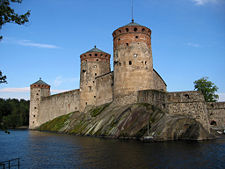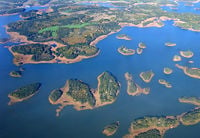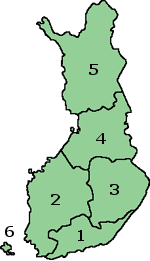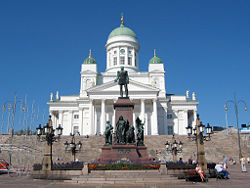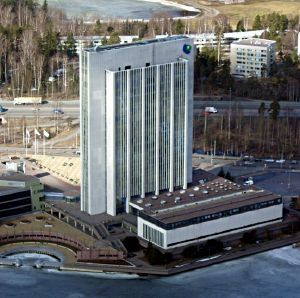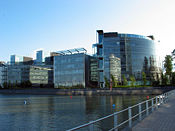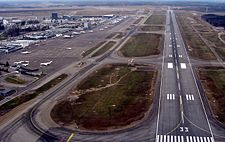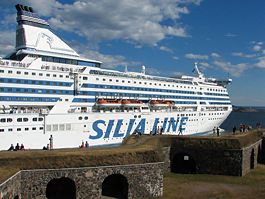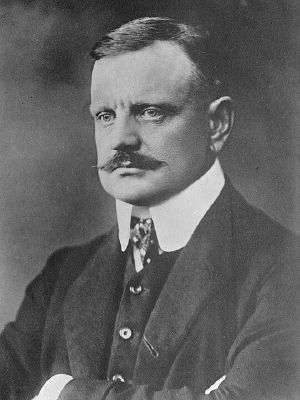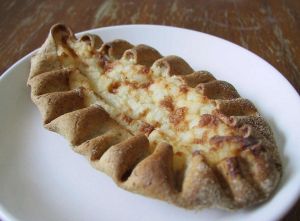Finland
| Suomen tasavalta Republiken Finland Republic of Finland | |||||
| |||||
| Motto: none1 | |||||
| Anthem: Maamme "Our Land" | |||||
|
Location of Finland (dark orange) – in the European Union (light orange) | |||||
| Capital (and largest city) |
60°10′N 24°56′E | ||||
| Official languages | Finnish, Swedish | ||||
|---|---|---|---|---|---|
| Government | Parliamentary democracy2 | ||||
| - President | Tarja Halonen | ||||
| - Prime Minister | Matti Vanhanen | ||||
| Independence | from Bolshevist Russia | ||||
| - Autonomy | March 29, 1809 | ||||
| - Declared | December 6, 1917 | ||||
| - Recognised | January 3, 1918 | ||||
| Accession to EU | January 1, 1995 | ||||
| Area | |||||
| - Total | 338,145 km² (65th) 130,558 sq mi | ||||
| - Water (%) | 9.4 | ||||
| Population | |||||
| - 20063 estimate | 5,276,571[1][2] | ||||
| - 2000 census | 5,181,115 | ||||
| - Density | 16/km² 40/sq mi | ||||
| GDP (PPP) | 2005 estimate | ||||
| - Total | $163 billion | ||||
| - Per capita | $31,208 | ||||
| GDP (nominal) | 2005 estimate | ||||
| - Total | $193.491 billion | ||||
| - Per capita | $37,504 | ||||
| HDI (2004) | |||||
| Currency | Euro (€) 4 (EUR)
| ||||
| Time zone | EET (UTC+2) | ||||
| - Summer (DST) | EEST (UTC+3) | ||||
| Internet TLD | .fi 5 | ||||
| Calling code | +358 | ||||
| 1 The words vapaa, vankka, vakaa ("free, tough, stable") were suggested as addition to the coat of arms in 1936, but were dropped. 2 Semi-presidential system 3 December 2006. 4 Prior to 2002: Finnish markka. 5 The .eu domain is also used, as it is shared with other European Union member states. | |||||
The Republic of Finland (Finnish: Suomi, Suomen tasavalta, Swedish: Republiken Finland ▶) is one of the Nordic countries. Situated in Northern Europe, it shares land borders on the Scandinavian Peninsula with Sweden to the west, Russia to the east and Norway to the north while Estonia lies to its south. Finland is bounded by the Baltic Sea with the Gulf of Finland to the south and the Gulf of Bothnia to the west. The Åland Islands, off the south-western coast, are an autonomous, demilitarised administrative province of Finland.
Finland has a population of 5,276,571 people spread over more than 330,000 km² (127,000 sq mi) making it one of the most sparsely populated countries in the world. Finland is a democratic republic with a semi-presidential system and parliamentarism. Finland was previously part of the Swedish kingdom and later an autonomous Duchy in the Russian Empire, until it declared its independence on December 6, 1917. Finland is 11th on the 2006 United Nations Human Development Index[3] and ranked as the 6th happiest nation in the world by an independent scientific study.[4]
The Republic of Finland is a member state of the European Union and the United Nations. Along with Estonian, Hungarian and Maltese, Finnish is one of the few official languages of the European Union that is not of Indo-European origin.
History
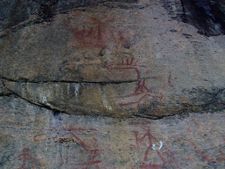
Prehistory (8500 B.C.E.– )
According to archaeological evidence, the area that is Finland was settled around 8500 BCE during the Stone Age as the ice shield of the last ice age receded. The earliest people were probably hunter-gatherers, living primarily off what the tundra and sea could offer. Pottery is known from around the 5300 B.C.E. (see Comb Ceramic Culture). Scientists believe it is probable that speakers of the Finno-Ugric language arrived in the area during the Stone Age (see Finno-Ugric peoples), and were possibly even among the first Mesolithic settlers in Europe.[6] The arrival of the Battle Axe culture (or Cord-Ceramic Culture) in southern coastal Finland around 3200 BCE may have coincided with the start of agriculture. However, the earliest certain records of agriculture are from the late 3rd millennium B.C.E. Hunting and fishing continued to be important parts of the subsistence economy, especially in the northern and eastern parts of the country.
The Bronze Age (1500–500 B.C.E.) and Iron Age (500 B.C.E.–1200 C.E.) were characterised by extensive contacts with other cultures in the Fennoscandian and the Baltic region. First written documents appear in the 12th century.
The Swedish reign (early Middle Ages–1809)
The beginning of Finland's over 600-year association with the Kingdom of Sweden traditionally dates from the year 1155[7] and the probable introduction of Christianity by Sweden's King Erik after a military expedition known as the First Swedish Crusade. Historically verifiable date of the conquest is 1249 when Birger jarl conducted the so-called Second Swedish Crusade to Finland. Swedish became the dominant language of administration and education; Finnish chiefly a language for the peasantry, clergy and local courts in predominantly Finnish-speaking areas. The society was divided in four estates of the realm: nobility, clergy, burghers and peasants, who represented the majority, and the estateless.
In the 16th century were the first written works published in Finnish by Mikael Agricola, and during this time, the Swedish empire (i.e. Sweden and Finland) converted to Lutheranism, the current mainstream religion. The Swedish kingdom systematically settled areas and built cities in Finland, particularly in the east, such as in Ingria and Kainuu. Governor General Per Brahe the Younger founded ten cities and the first university in Finland, the The Royal Academy of Turku. The establishment of universal literacy and rule of law also dates to this time. Finnish people participated in wars of the Swedish kingdom, and Finnish warriors of Sweden's army became known as Hakkapeliittas.
The Swedish Kingdom strove to push the borders eastward, which led to wars of varying success with Novgorod. The expansion was halted by the unification of Russia and was eventually rolled back. During the 18th century, virtually all of Finland was twice occupied by Russian forces, known by the Finns as the Greater Wrath (1714–1721) and the Lesser Wrath (1742–1743). During this time "Finland" became the predominant term for the whole land area from the Gulf of Bothnia to the Russian border; both in domestic Swedish debate and by Russians promising protection from "Swedish oppression".
The earlier Finland – i.e., the south-western area – was from then on called "Finland Proper". The Finnish areas ceded to Russia in 1721 and 1743 (excluding Ingria) were called "Old Finland". In these areas the traditional freedom of peasants was constantly pushed towards the oppressed position peasants had in other parts of Russia.
Finland as a Grand Duchy in Russian Empire (1809–1917)
On March 29 1809, after being conquered by the armies of Russian Emperor Alexander I from Sweden in the Finnish War, Finland became an autonomous Grand Duchy under the Russian Empire until the end of 1917. Old Finland was returned to the Grand Duchy in 1812. During the Russian era, the Finnish language started to gain recognition by both the imperial court and the governing bodies, first probably to sever the cultural and emotional ties with Sweden and thereafter, from the 1860s onwards, as a result of a strong nationalist movement, known as the Fennoman movement. Milestones included the publication of what would become Finland's national epic, the Kalevala, in 1835; and the Finnish language achieving equal legal status with Swedish in 1892.
In 1906, universal suffrage was adopted in the Grand Duchy of Finland, as the second country in the world. However, the relationship between the Grand Duchy and the Russian Empire gradually soured when the Russian government made moves to restrict the Finnish autonomy. Wishes for national independence gained ground, first among radical nationalists and socialists.
The Independent Republic, Civil War (1917–1918)
On December 6, 1917, shortly after the Bolshevik Revolution in Russia, Finland declared its independence. The independence was approved by Bolshevist Russia but the Civil Wars that followed in Russia and in Finland and activist expeditions (see Heimosodat), including the ones to White Karelia and Aunus, complicated relations.
In 1918, the country experienced a brief but bitter Civil War that coloured domestic politics for many years. The Civil War was fought between "the whites", who gained support from Imperial Germany, and "the reds", supported by Bolshevist Russia. The reds consisted mostly of leftist propertyless rural and industrial workers who, despite universal suffrage in 1906, felt that they lacked political influence. The white forces were mostly made up of bourgeoisie and wealthy peasantry, politically more to the right. Eventually, the whites overcame the reds. The deep social and political dividing line and mutual enmity between the Reds and Whites remained.
The Inter-war era (1918–1939)
Despite the Declaration of Independence calling Finland a Republic after the Civil War, the parliament, cleared of its Social Democrat members, voted with a narrow majority to establish the Kingdom of Finland. Frederick Charles of Hesse, a German prince, was elected King, putatively with the name Väinö I of Finland, with Pehr Evind Svinhufvud and General Mannerheim serving as Regents. However, Germany's defeat in World War I meant that the idea was abandoned. Finland instead became a republic, with Kaarlo Juho Ståhlberg elected as its first President in 1919.
The Finnish–Russian border was agreed upon in the Treaty of Tartu in 1920, largely following the historic border but granting Pechenga (Finnish: Petsamo) and its Barents Sea harbour to Finland.
Finnish democracy survived the upsurge of the extreme right and financial crisis during the early '30s. However, legislators reacted against communism and the relationship between Finland and the Soviet Union remained tense.
Finland in World War II (1939–1945)

During World War II, Finland fought the Soviet Union twice: in the Winter War of 1939–1940 and in the Continuation War of 1941–1944 in accordance with Operation Barbarossa in which Germany invaded the Soviet Union. This was followed by the Lapland War of 1944–1945, when Finland forced the Germans out of northern Finland. After the wars there were land mine clearance operations in Karelia and Lapland plus the enormous task of naval mine clearance in the Gulf of Finland and the Baltic Sea during 1944–1950. The mines in Lapland especially slowed down the rebuilding and caused casualties.
Treaties signed in 1947 and 1948 with the Soviet Union included obligations, restraints, and reparations on Finland vis-à-vis the Soviet Union as well as further Finnish territorial concessions (cf. the Moscow Peace Treaty of 1940). Finland ceded most of Finnish Karelia, Salla, and Petsamo, which amounted to 10% of its land area, 20% of industrial capacity and 400,000 evacuees, mainly women and children. Establishing trade with the Western powers, such as Great Britain, and the reparations to the Soviet Union caused Finland to transform itself from a primarily agrarian economy to an industrialised one. Even after reparations were fulfilled, Finland continued to trade with the Soviet Union in the framework of bilateral trade. Ultimately, the Soviet Union had a national debt to Finland. Russia assumed the debt after the dissolution of the Soviet Union and finally cleared it in 2006.
The Post-war era and modern history
After the Second World War, neutral Finland lay in the grey zone between the western countries and the Soviet Union. The "YYA Treaty" (Finno-Soviet Pact of Friendship, Cooperation, and Mutual Assistance) gave the Soviet Union some leverage in Finnish domestic politics. This was extensively exploited, perfectly legally and constitutionally, by President Urho Kekkonen against his opponents. He maintained an effective monopoly on Soviet relations, which gave him a status of "only choice for president". There was also a tendency of self-censorship regarding Finno-Soviet relations. This phenomenon was given the name Finlandisation by the German press. However, Finland maintained a democratic government and a market economy unlike most other countries bordering the Soviet Union.
The post-war era was a period of rapid economic growth and increasing wealth and stability for Finland. In all, the war-ravaged agrarian country was transformed into a technologically advanced market economy with a sophisticated social welfare system. When the Soviet Union fell in 1991, the bilateral trade disappeared overnight, and the economy collapsed. Finland was simultaneously hit by a "home-cooked" severe depression. This left a mass unemployment problem, but the economy survived and began growing at a high rate after the depression. Finland joined the European Union in 1995, where it is an advocate of federalism contrary to the other Nordic countries that are predominantly supportive of confederalism.[8]
The first modern democracy
The Parliament of Finland is celebrating its centenary in 2006 and 2007. The 100th anniversary of the approval of the Parliament Act and Election Act by the Diet was on June 1, 2006. May 23, 2007 is the 100th anniversary of the first plenary session of Finland's unicameral parliament. The theme of the centenary is "The right to vote – trust in law. One hundred years of Finnish democracy."
The anniversary festivities focus on the parliamentary reform of the early 20th century and the introduction of equal and universal suffrage and full political rights for women. These reforms included the introduction of a proportional representation, open list voting system as well as the right to vote and to also be elected for all citizens, including women. A total of 19 female MPs were elected in the first election. On May 23, 2006, a statue was unveiled to honour the work of female MPs.
A hundred years ago, Finland was an autonomous part of the Russian Empire. The members of the four estates in the then autonomous legislative assembly, the diet, represented only a small fraction of the population. A reform of the parliamentary system and electoral law gave Finland the first modern representative institution and democracy in the world. Universal and equal eligibility and suffrage was introduced, irrespective of land ownership or gender. Finnish women became among the first in the world to enjoy full political rights, resulting in 19 elected women in the first modern democratic election.[9]
Etymology
The name Suomi has uncertain origins but a strong candidate for a cognate is the Baltic word zeme meaning "ground, earth, country".
The exonym Finland has resemblance with e.g. the Scandinavian placenames Finnmark, Finnveden and Finnskogen and all are thought to be derived from finn, a Germanic word for nomadic "hunter-gatherers" (as opposed to sedentary farmers). How, why and when this designation would have started to mean the Finns in particular is largely unknown. Among the first written documents mentioning a "land of the Finns" are two rune stones. There is one in Söderby, Sweden, with the inscription finlont (U 582 †) and one in Gotland, a Swedish island in the Baltic Sea, with the inscription finlandi (G 319 M) dating from the 11th century.[10]
Geography and environment
Topography and geology
Finland is a country of thousands of lakes and islands; 187,888 lakes (larger than or 500 m²) and 179,584 islands.[11] One of these lakes, Saimaa, is the 5th largest in Europe. The Finnish landscape is mostly flat with few hills and its highest point, the Halti at (1,328 meters), is found in the extreme north of Lapland at the border between Finland and Norway. Taiga covers 75% of land area with coniferous forests, fens, and little arable land. Granite is uiquitous throughout Finland, visible wherever there is no soil cover. Moraine or till is the most common type of soil, with a thin layer of humus of biological origin. Most of the islands are found in the Archipelago Sea, as part of the archipelago of the Åland Islands, and along the southern coast in the Gulf of Finland. Finland is one of the few countries in the world that is still growing. Owing to the post-glacial rebound that has been taking place since the last ice age, the surface area of the country is growing by about 2.7 square miles each year (7 square kilometers).[12]
Finland has a diverse array of flora and fauna, ranging throughout the various climatic zones. There are over 1,200 species of vascular plant, 800 bryophytes and 1,000 lichen species in Finland, with flora being richest in the southern mainland and Åland Islands. Plant life, like most of the Finnish ecology, is well adapted to tolerate the contrasting seasons and extreme weather. Finland has arelatively new ecology given that many plant species, such as the Scots Pine, spruce, birch and oak, spread throughout Finland from Norway and only reached the western coast less than three millennia ago.
Similarly, Finland has a diverse and extensive range of fauna. Interestingly, all terrestrial animals were completely wiped out during the last ice age. The animals arrived in Finland about 10,000 years ago, following the retreat of the glaciers and the appearance of vegetation. Nowadays there are at least 60 native mammals, 248 breeding birds, over 70 fish and 11 reptile and frog species present today, many migrating from neighbouring countries thousands of years ago.
Of large wildlife mammals, the most common are the Brown Bear (national animal), Gray Wolf, moose and reindeer. Other common mammals include the Red Fox, Red Squirrel, and Mountain Hare. Some rare and exotic species include the flying squirrel, Golden Eagle, Saimaa Ringed Seal and Arctic fox, which is considered the most endangered. Whooper Swan, the national bird of Finland, is a large Northern Hemisphere swan. The most common breeding birds are the Willow Warbler, Chaffinch and Redwing.[13] Of some 70 species of freshwater fish, the northern pike, perch and others are plentiful. Salmon remains the favorite of fly rod enthusiasts.
The Saimaa Ringed Seal, one of only three lake seal species in the world, has become the emblem of the Finnish Association for Nature Conservation and only through dedicated work by conservationists has this amazing seal been saved from extinction. Due to hunting and persecution in history, many animals such as the Golden Eagle, Brown Bear and Eurasian Lynx all experienced significant declines in population. However, as a result of careful conservation, the establishment of vast national parks and general ‘encouragement’, numbers have increased dramatically in recent years.
Climate
The climate in Southern Finland is a northern temperate climate. In Northern Finland, particularly in the Province of Lapland, a subarctic climate dominates, characterised by cold, occasionally severe, winters and relatively warm summers. The main factor influencing Finland's climate is the country's geographical position between the 60th and 70th northern parallels in the Eurasian continent's coastal zone, which shows characteristics of both a maritime and a continental climate, depending on the direction of air flow. Finland is near enough to the Atlantic Ocean to be continuously warmed by the Gulf Stream, which explains the unusually warm climate considering the absolute latitude.
A quarter of Finland's territory lies above the Arctic Circle, and as a consequence the midnight sun can be experienced — for more and more days, the further up north one comes. At Finland's northernmost point, the sun does not set for 73 consecutive days during summer, and does not rise at all for 51 days in winter.
Administrative divisions
Provinces
Finland is divided into 6 administrative provinces (lääni, pl. läänit) that are further divided into 90 state local districts. The provincial authority is part of the executive branch of the national government, and has no elected officials. This system was created in 1634, and underwent few major changes until the redivision of the country into "greater provinces" in 1997. Since then, the six provinces have been – referring to the picture on the right:Southern Finland, Western Finland, Eastern Finland, Oulu, Lapland, and Åland. These provinces are merely administrative divisions. Western Finland, for example, spans four major linguistic and dialectal areas (Ostrobothnian dialects, Southwestern dialects, Savo in mideast, and some Swedish speakers in the area around Vaasa).
The Åland Islands enjoy a degree of autonomy. According to international treaties and Finnish laws, the regional government for Åland handles some matters that would belong to the provincial authority in Mainland Finland. The same international treaties create an official language for Åland: one must speak Swedish to own land in Åland.
There are provinces that echo the pattern of colonization of Finland. Dialects, folklore, customs, and people's feeling of affiliation are associated with these historical provinces of Finland, although the re-settlement of 420,000 Karelians during World War II and urbanization in the latter half of the 20th century have made the distinctions less obvious. The old provinces or counties (1634–1997) survive in the telephone numbering areas.
Demographics
| Population of Finland, 1750–2000[14]
In the following chart, the number of inhabitants includes those living in the entire municipality (kunta), not just in the built-up area. The land area is given in km², and the density in inhabitants per km² (land area). The figures are as of January 1, 2007. Notice that the capital region – comprising Helsinki, Vantaa, Espoo and Kauniainen – forms a continuous conurbation of about one million people and is effectively a single city in economic terms. However, common admistration is limited to voluntary cooperation of all municipalities, e.g. in Helsinki Metropolitan Area Council. |
Year | Population | Year | Population | |||
|---|---|---|---|---|---|---|---|
| 1750 | 421,000 | 1880 | 2,060,800 | ||||
| 1760 | 491,000 | 1890 | 2,380,100 | ||||
| 1770 | 561,000 | 1900 | 2,655,900 | ||||
| 1780 | 663,000 | 1910 | 2,943,400 | ||||
| 1790 | 705,600 | 1920 | 3,147,600 | ||||
| 1800 | 832,700 | 1930 | 3,462,700 | ||||
| 1810 | 863,300 | 1940 | 3,695,617 | ||||
| 1820 | 1,177,500 | 1950 | 4,029,803 | ||||
| 1830 | 1,372,100 | 1960 | 4,446,222 | ||||
| 1840 | 1,445,600 | 1970 | 4,598,336 | ||||
| 1850 | 1,636,900 | 1980 | 4,787,778 | ||||
| 1860 | 1,746,700 | 1990 | 4,998,478 | ||||
| 1870 | 1,768,800 | 2000 | 5,181,000 | ||||
Population
Finland numbers 5,276,571 inhabitants and has an average population density of 17 inhabitants per square kilometre.[1] This makes it, after Norway and Iceland, the most sparsely populated country in Europe. Finland's population has always been concentrated in the southern parts of the country]. The biggest and most important cities in Finland are the Greater Helsinki metropolitan area (including the cities of Helsinki, Vantaa, Espoo and Kauniainen), and Tampere, Turku, and Oulu.
After the Winter War of 1939 (and confirmed by the outcome of the Continuation War of 1941), 12% of Finland's population had to be re-settled. War reparations, unemployment, and uncertainty regarding Finland's chances to remain sovereign and independent of the Soviet Union contributed to considerable emigration, abating first in the 1970s. Until then, some 500,000 Finns had emigrated, chiefly to Sweden, although half of the emigrants ultimately migrated back.
Since the late 1990s, Finland has received refugees and immigrants at a rate comparable with the other Nordic countries, although the total ethnic-minority population remains far lower in Finland. Finland is ethnically a very homogeneous country. Foreigners represent only 2% of the population. A considerable number of immigrants originates from the former Soviet Union claiming ethnic (Finnic) kinship.
Finnish is in the Finno-Ugric language family and is typologically an agglutinative language. It modifies and inflects the forms of nouns, adjectives, pronouns, numerals and verbs depending on their roles in the sentence. It is likely that speakers of the Finno-Ugric language arrived in the area during the Stone Age. The first written form of Finnish was created by Mikael Agricola, a Finnish bishop in the 16th century who also published the first book in Finnish. The written form was subsequently revised by many others.
The largest minority languages in Finland are Swedish (5.5%), Russian (0.8%) and Estonian (0.3%). To the north, in Lapland, the Sami, numbering less than 7,000, like the Finns, speak a Finno-Ugric language. There are three Sami languages that are spoken in Finland: Northern Sami (majority), Inari Sami (300–400 people) and Skolt Sami (400 people). Swedish has an official language status in Finland, and the right of other minority groups (in particular Sami people) to cherish their culture and language is protected by law. Over 20 languages are now spoken in Finland by immigrant groups of significant size — that is, with at least a thousand speakers.
The majority of Finns are also proficient in English, learned in school and from media. Other common secondary languages are German, French, and Swedish.
The Sami live in Finland, Sweden, Norway, and Russia. Known widely in the past as Lapps, a term now considered derogatory by many Sami. In addition to their own Sami languages, Sami have their own way of life and identity. Common history, traditions, livelihoods, and customs unite the Sami living in different countries. In total, there are about 75,000 to 100,000 Samis, fewer than 7,000 living in Finland, forming roughly 0.13% of the population.
Most Finns are members of the Evangelical Lutheran Church of Finland (82.4%)[15], with a minority of 1.1% belonging to the Finnish Orthodox Church (see Eastern Orthodox Church). The remainder of the population consists of small groups (totaling 1.1%) of other Protestant denominations, Catholics, Muslims and Jews beside the growing population of unaffiliated (15.4%)[16]. The main Lutheran and Orthodox churches are the official churches of Finland. However, church attendance is much lower than these figures may suggest. Most of the population holds generally secular views. A majority of members of the state Lutheran Church do not participate actively, and even then it is mostly for occasions like weddings and funerals.[17]
Finnish family life is centered around the nuclear family. Relations with the extended family are often rather distant, and Finnish people do not form politically significant clans, tribes, or similar structures. According to UNICEF, Finland ranks fourth in child well-being.[18]
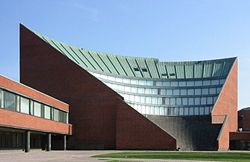
The Finnish education system is a comparatively egalitarian Nordic system, with no tuition fees for full-time students. Attendance is compulsory between the ages of 7 and 16, and free meals are served to pupils at primary and secondary levels. The first nine years of education (primary and secondary school) are compulsory. Secondary education is not compulsory; it is either a trade school, or preparation for tertiary education. In higher education, there are two mostly separate sectors: the higher vocational schools and universities. In the OECD's international assessment of student performance, PISA, Finland has consistently been among the highest scorers worldwide; in 2003, Finnish 15-year-olds came first in reading literacy, science, and mathematics; and second in problem solving, worldwide. The World Economic Forum ranks Finland's higher education first in the world.[19]
Finland has a public health care system. 18.9% of health care is funded by households themselves, 76.6% is publicly funded, and the rest of the funding comes from elsewhere. There are 307 residents for each doctor.[20] After having one of the highest death rates from heart disease in the world in the 1970s, improvements in the Finnish diet and exercise have paid off. Finland is now one of the healthiest countries in the world.[21]
The life expectancy is 82 years for women and 75 years for men.
Government and politics

Political system
Unlike the Scandinavian countries (Denmark, Norway, and Sweden) which are constitutional monarchies, Finland has a republican form of government. Finland has a semi-presidential system with parliamentarism. The president is responsible for foreign policy outside of the European Union. Most executive power lies in the cabinet (the Finnish Council of State) headed by the Prime Minister. Responsibility for forming the cabinet out of several political parties and negotiating its platform is granted to the leader of the party gaining largest support in the elections for the parliament. This person also becomes Prime Minister of the cabinet. Any minister and the cabinet as a whole however must have continuing trust of the parliament and may be voted out, resign or be replaced. The Council of State is made up of the Prime Minister and the ministers for the various departments of the central government as well as an ex-officio member, the Chancellor of Justice.
The 200-member unicameral parliament is called the Eduskunta (Finnish) or Riksdag (Swedish). It is the supreme legislative authority in Finland. The parliament may alter the Constitution of Finland, bring about the resignation of the Council of State, and override presidential vetoes. Its acts are not subject to judicial review. Legislation may be initiated by the Council of State, or one of the Eduskunta members, who are elected for a four-year term on the basis of proportional representation through open list multi-member districts.
The judicial system of Finland is divided between courts with regular civil and criminal jurisdiction and administrative courts with responsibility for litigation between the individuals and the administrative organs of the state and the communities. Finnish law is codified and its court system consists of local courts, regional appellate courts, and the Supreme Court. The administrative branch of justice consists of administrative courts and the Supreme Administrative Court. In addition to the regular courts, there are a few special courts in certain branches of administration. There is also a High Court of Impeachment for criminal charges (for an offence in office) against the President of the Republic, the justices of the supreme courts, members of the Council of State, the Chancellor of Justice and the Ombudsman of Parliament.
The parliament has, since equal and common suffrage was introduced in 1906, been dominated by secular Conservatives, the Centre Party (former Agrarian Union), and Social Democrats, which have approximately equal support, and represent 65–80% of voters. After 1944 Communists were a factor to consider for a few decades. The relative strengths of the parties vary only slightly in the elections due to the proportional election from multi-member districts but there are some visible long-term trends.
Regions and municipalities
Black borders refer to municipalities, red to regions.
Legally, Finland has two levels of democratic government: the state, and 416 municipalities (as of January 1, 2007). The municipality is the same as a "city" level of government, except that rural municipalities are not called "cities". Since 1977, no legal or administrative distinction is made between towns, cities and other municipalities. Although a municipality must follow the laws set by the state, it makes independent decisions. That is, the decisions of a municipal council, if legal, cannot be appealed. People often identify with their municipality, although their nationality is usually more important.
Municipalities co-operate in 74 sub-regions and 20 regions. These are governed by the member municipalities. The Åland region has a permanent, democratically elected regional council, as a part of the autonomy. In the Kainuu region, there is a pilot project underway, with similar regional elections.
The constitution of Finland and its place in the judicial system are unusual in that there is no constitutional court and the supreme court does not have an explicit right to declare a law unconstitutional. In principle, the constitutionality of laws in Finland is verified by a simple vote in the parliament (see Parliamentary sovereignty). However, the Constitutional Law Committee of the parliament reviews any doubtful bills and recommends changes, if needed. In practice, the Constitutional Law Committee fulfils the duties of a constitutional court. A Finnish peculiarity is the possibility of making exceptions to the constitution in ordinary laws that are enacted in the same procedure as constitutional amendments. An example of such a law is the State of Preparedness Act which gives the Council of State certain exceptional powers in cases of national emergency. As these powers, which correspond to US executive orders, affect constitutional basic rights, the law was enacted in the same manner as a constitutional amendment. However, it can be repealed in the same manner as an ordinary law. In addition to preview by the Constitutional Law Committee, all Finnish courts of law have the obligation to give precedence to the constitution when there is an obvious conflict between the constitution and a regular law. That is, however, very rare. The only other European countries that lack a constitutional court are the Netherlands and the United Kingdom (which does not have a codified constitution).
After the collapse of the Soviet Union in 1991, Finland freed itself from the last restrictions imposed on it by the Paris peace treaties of 1947. The Finno-Soviet Agreement of Friendship, Cooperation, and Mutual Assistance (and the restrictions included therein) was annulled but Finland recognised the Russian Federation as the successor of the USSR and was quick to draft bilateral treaties of goodwill as well as reallocating Soviet debts.
Finland deepened its participation in the European integration by joining the European Union with Sweden and Austria in 1995. It could be perhaps said that the country's policy of neutrality has been moderated to "military non-alignment" with an emphasis on maintaining a competent independent defence. Peacekeeping under the auspices of the United Nations is the only real extra-national military responsibility which Finland undertakes.
According to Transparency International, Finland has had the lowest level of corruption in all the countries studied in its survey for the last several years.[22]
President
The President of Finland is the Head of State of Finland. Under the Constitution of Finland, executive power is vested in the President and the government, with the President possessing extensive powers. The President is elected directly by the people for a term of six years. Since 1991, no President may be elected for more than two consecutive terms. The President must be a native-born Finnish citizen. The office was established by the Constitution Act of 1919.
The current office-holder is President Tarja Halonen. She began her first term of office in 2000 and was re-elected on January 29, 2006. Her current term expires in 2012. She is the eleventh President of Finland and the first woman to hold the office.
| Presidents of Finland | ||
|---|---|---|
| Name | Born–Died | In office |
| Kaarlo Juho Ståhlberg | 1865–1952 | 1919–1925 |
| Lauri Kristian Relander | 1883–1942 | 1925–1931 |
| Pehr Evind Svinhufvud | 1861–1944 | 1931–1937 |
| Kyösti Kallio | 1873–1940 | 1937–1940 |
| Risto Heikki Ryti | 1889–1956 | 1940–1944 |
| Carl Gustaf Emil Mannerheim | 1867–1951 | 1944–1946 |
| Juho Kusti Paasikivi | 1870–1956 | 1946–1956 |
| Urho Kaleva Kekkonen | 1900–1986 | 1956–1981 |
| Mauno Henrik Koivisto | 1923– | 1982–1994 |
| Martti Oiva Kalevi Ahtisaari | 1937– | 1994–2000 |
| Tarja Kaarina Halonen | 1943– | 2000– |
Parliament
The Finnish Parliament consists of one chamber with 200 members. The members are elected for a four-year term by direct popular vote under a system of proportional representation. According to the Constitution of Finland, the Parliament elects the Prime Minister, who is appointed to office by the President. Other Ministers are appointed by the President on the Prime Minister's proposal. The current Prime Minister of Finland, as well as Chairman of the Centre Party is Matti Vanhanen (who in the second half of 2006 was President of the European Council).
After the parliamentary elections on March 16, 2003, the seats were divided among eight parties as follows:
The next Finnish parliamentary election is scheduled to be held on March 18, 2007.
Foreign relations
The Ministry for Foreign Affairs is responsible for Finnish foreign policy. Current Minister for Foreign Affairs and Head of Office is Erkki Tuomioja. Finland's foreign policy is based on the membership of the European Union with its customs union, military non-alliance, and neutrality. Finland is also in the Nordic Council, and has long traditions of co-operation with the Nordic countries. Finland has good relations with all its neighbours, Sweden, Norway, Russia and Estonia, and is not involved in international conflicts or border disputes. The military doctrine is strictly self-defensive, and indeed, the Constitution of Finland allows participation only in military operations authorised by the UN or the OSCE. Public opinion is against joining any military alliances, such as NATO, although Finland is involved in the Partnership for Peace programme with NATO. Foreign trade is highly important, as about a third of the gross domestic product comes from foreign trade, and Finland depends on imports for most raw materials.
Defense Forces
The Finnish Defence Forces is a cadre army of 16,500, of which 8,700 professional soldiers (officers), with a standard readiness strength of 34,700 people in uniform (27,300 Army, 3,000 Navy, and 4,400 Air Force). Finland's defence budget equals about 1.4% of the GDP. A universal male conscription is in place, under which all men above 18 years of age serve from 6 to 12 months. Inhabitants of Finland's Åland Islands and Jehovah's Witnesses are exempt, but there are no other general exemptions. Also a 13-month-long non-military service is possible. As of 1995, women were permitted to serve on a voluntary basis. The defence is based on a large trained reserve. During the Cold War, Finland could have mobilised 490,000 reservists in a conflict, but this number has since been reduced to some 350,000 due to ongoing budget cuts.
The Finnish Defense Forces are under the command of the Chief of Defense, who is directly subordinate to the President of the Republic in matters related to the military command. The current Chief of Defense is Admiral Juhani Kaskeala.
The military branches are Finnish Army, Finnish Navy and Finnish Air Force. The Border Guard is under the Ministry of the Interior but can be incorporated into the Defence Forces when required by defence readiness.
Energy policy
The Ministry of Trade and Industry is responsible for the Government's energy policy. Energy policy is of exceptional importance, for Finland needs a lot of energy because of its cold climate and the structure of its industry, but has no fossil fuel energy resources, like oil or coal. It has thus done pioneering work on developing more efficient ways of using energy. Also, Finland refines oil to cover domestic needs: the Finnish corporation Neste Oil has two oil refineries. Finland is connected to the Nordpool, the Nordic electricity market.
Until the 1960s, Finnish energy policy relied on the electricity produced by hydropower stations and extensive decentralised use of wood for energy. Finland's 187,888 lakes do not lie much above sea level – less than 80 metres in the case of the two biggest lakes, Saimaa and Päijänne. Consequently, Finland has less hydropower capacity than Sweden, for example, not to mention Norway.
Finland started planning the introduction of nuclear power in the 1950s. In 2001, 18% of all electricity consumed in Finland was produced by the country's four nuclear power plants.[23] Energy policy became a burning issue in Finland when industry applied for permission to build a new nuclear power unit, Finland's fifth. On May 24, 2002, Parliament supported the application by 107 votes to 92. After the vote, the The Green League resigned from the government where they had held the environment portfolio. All the other parties were divided over the nuclear issue. The fifth nuclear power station is currently under construction. It is being built by the French Areva.
Most of the energy is produced from fossil fuels, mainly coal and oil. Fossil fuels are, however, all imported, because Finland doesn't have any fossil fuel sources, unlike neighboring Norway with oil and Estonia with oil shale. Nevertheless, Finland fares exceptionally well with renewable energy. About one fifth of all the energy consumed in Finland is wood-based. This is not a remnant of old ages – quite the contrary: pulp and paper industry, the largest industry in Finland, burns its byproducts, such as black liquor residues and waste wood chippings. In fact, a pulp mill is a net energy seller, not buyer. Also, many homeowners also own renewed forests, and use wood as an additional (but not primary) heat source. About 7% of electricity is produced from peat harvested from Finland's extensive bogs. Peat is "bioenergy", but there is no consensus whether it is renewable – carbon neutral – or not.
Currently, some electricity is imported to Finland. In recent years, a varying amount (5–17%) of power has been imported from Russia, Sweden and Norway. The Norwegian and Swedish hydroelectric plants remain an important source for imported power. The current energy policy debate is centred on self-sustainability. There are plans to build an electric cable to Russia, but this is also considered a national security issue.
Industry, economy and globalisation
General situation
In the past, Finnish trade relationships and politics were by large determined by avoidance of provoking first the feudally ruled Imperial Russia and then the totalitarian Soviet Union. Despite the hindrance caused by an influential neighbouring country, Finland eventually became one of the most globalised nations in the world. After the Second World War, the growth rate of the GDP was high compared to other Europe, and Finland was often called "Japan of the North". In the beginning of the 1970s, Finland's GDP per capita reached the level of Japan and the UK.
For decades now, Finland has had a highly industrialised, largely free-market economy with a per capita output equal to that of other western economies such as for example Sweden, UK, France and Germany. Services is the largest sector of the economy. However, with respect to foreign trade, the key economic sector is manufacturing of principally wood, metal, engineering, telecommunications and electronic products. International trade is important, with exports equalling almost one-third of GDP. Except for timber and several minerals, Finland depends on imports of raw materials, energy and some components for manufactured goods.
In 1991, Finland experienced an economic collapse and fell into a severe depression caused by economic overheating, depressed foreign markets and the dismantling of the barter system between Finland and the former Soviet Union. More than 20% of Finnish trade was with the Soviet Union before 1991, and in the following two years the trade practically ceased. The growth in the 1980s was based on debt, and when the defaults began rolling in, an avalanche effect increased the unemployment from a virtual full employment to one fifth of the workforce. However, civil order remained and the state alleviated the problem of funding the welfare state by taking massive debts. 1991 and again in 1992, Finland devalued the markka to promote export competitiveness. This helped stabilise the economy; the depression bottomed out in 1993, with continued growth through 1995. Since then the growth rate has been one of the highest of OECD countries, and national debt has been reduced to 41.1% (fulfilling the EU's Stability and Growth Pact requirement).
Because of the northern climate, agricultural development is limited to maintaining self-sufficiency. Forestry, an important export earner, provides a secondary occupation for the rural population.
Finland was one of the 11 countries joining the euro monetary system (EMU) on January 1, 1999. The national currency markka (FIM), in use since 1860, was withdrawn and replaced by euro (EUR) in the beginning of 2002. (See also: Finnish euro coins)
Finland has been declared the most competitive country in the world for three consecutive years 2003–2005 (four times in the last five years) by the World Economic Forum.[24] In recent years there has been national focus on innovation and research and development, with special emphasis on information technology.[25] It could be said that Nokia, in its own right, is the secret behind the Finns' success in harnessing what is one of today's most promising branches of industry, the telecommunications sector.
Public transport
The transport network of Finland is developed. As of 2005, the country's network of main roads has a total length of 13,258 km, and is mainly centred on the capital city of Helsinki. The total length of all public roads is 78,186 km, of which 50,616 km are paved. The motorway network is still to a great extent under development, and currently totals 653 km. There are 5,865 km of railways in the country. Helsinki has an urban rail network, and light rail systems are currently being planned in Turku and Tampere. Finland also has a considerable number of airports and large ports.
The Finnish rail system is called VR. It offers InterCity and express trains throughout the country and the faster Pendolino trains connecting the major cities. There are very large discounts (usually 50%) available for children (7–16 yr), students, senior citizens and conscripts. There are international trains to St. Petersburg (Finnish and Russian day-time trains) and Moscow (Russian over-night train) to Russia. Connections to Sweden are by bus due to rail gauge differences. It's possible to take the Silja Line and Viking Line ferries from Helsinki to Mariehamn in the Åland archipelago, Stockholm (Sweden) and Tallinn (Estonia). There are about 25 airports in Finland with scheduled passenger services. Finnair, Blue1 and Finncomm Airlines provide air services both domestically and internationally. Helsinki-Vantaa Airport is Finland's global gateway with scheduled non-stop flights to such places as Bangkok, Beijing, Delhi, Guangzhou, Nagoya, New York, Osaka, Shanghai, Hong Kong and Tokyo. Helsinki has an optimal location for great circle airline traffic routes between Western Europe and the Far East. Hence, many foreign tourists visit Helsinki on a stop-over while flying from Asia to Europe or vice versa.
Tourism
Tourism is an expanding industry in Finland and has become a significant aspect of its economy in recent years. In 2005, Finnish tourism grossed over €6.7 billion with a 5% increase from the previous year. Much of the sudden growth can be attributed to the globalisation and modernisation of the country as well as a rise in positive publicity and awareness. There are many attractions in Finland which attracted over 4 million visitors in 2005.
The Finnish landscape is covered with thick pine forests, rolling hills and complemented with a labyrinth of lakes and inlets. Much of Finland is pristine and virgin as it contains 35 national parks from the Southern shores of the Gulf of Finland to the high fells of Lapland. It is also an urbanised region with many cultural events and activities.
Commercial cruises between major coastal and port cities in the Baltic region, including Helsinki, Turku, Tallinn, Stockholm and Travemünde, play a significant role in the local tourism industry.
Tourism in winter
Although many tourists visit for the ideal weather during the summer, winter also attracts hundreds of thousands for its Christmas festivities and winter sports and activities such as skiing, dog sledding and Nordic walking. Finland is regarded as the home of Saint Nicholas or Santa Claus. Santa’s Post Office is also located in Finland, up in the northern Lapland region. Above the arctic circle, there is a polar night, a period when the sun doesn't rise for days or weeks. The polar lights in Finland also known as Aurora Borealis are an exquisite spectacle that draw people from around the globe.
Tourism in summer
Throughout the summer there are a range of international festivals, markets and performing arts including song and dance. The receding snow and everlasting sunlight also provide an opportunity for an array of outdoor activities. These activities range from golf, fishing, yachting, lake cruises, hiking, kayaking among many others. In the heart of summer, the Sun does not completely set and produces magnificent rays of light across the sky. Wildlife is abundant in Finland. Bird-watching is popular for those fond of flying fauna, however hunting is also popular. Moose, elk, reindeer and hare are all common game in Finland. The sport is highly regulated and also helps the economy.
Cultural attractions
Finland is also a place rich in culture for history, tradition and religion. There are churches and cathedrals scattered all across Finland reflecting the strong Finnish Lutheran following. There are also museums and examples of ancient architecture remaining from the reign of the Swedish Empire over much of Finland. These sites allure thousands for their significance and historical insight. Castles from the Swedish reign are found, for example in Turku, Hämeenlinna, Savonlinna. The Turku Castle is a museum. Olavinlinna in Savonlinna hosts the annual Savonlinna Opera Festival. The city of Helsinki, on the other hand, is famous for its Grand Duchy era architecture, which resembles that of imperial St. Petersburg.
Culture
Like the people, Finnish culture is indigenous and most prominently represented by the Finnish language. Since its earliest contact with foreign peoples and monarchs, Finns have been influenced by Western Europe (particularly Sweden and Germany) and, more recently, North America. There are very few Russian influences, with the exception of the 1.1% Orthodox minority. Into the twenty-first century, many Finns have been willing to incorporate many other cultural styles from even further abroad, such as Asia and Africa. More than just for tourism, Finnish youth in particular have been increasing their contact with peoples from the outside by travelling abroad to both work and study.
There are still differences between regions, especially minor differences in accents and vocabulary. Minorities maintain their own cultural characteristics, such as the Sami and Finland Swedes. Many Finns are emotionally connected to the countryside and nature, as urbanisation is a relatively recent phenomenon.
Music
Much of the music of Finland is influenced by Karelian traditional tunes and lyrics, as comprised in the Kalevala. Karelian culture is perceived as the purest expression of the Finnic myths and beliefs, less influenced by Germanic influence, in contrast to Finland's position between the East and the West. Finnish folk music has undergone a roots revival in recent decades, and has become a part of popular music. The people of northern Finland, the Sami, have their own musical traditions, collectively Sami music.
Modern Finnish popular music includes a renowned heavy metal scene, in common with other Nordic countries, as well as a number of prominent rock bands, jazz musicians and hip hop performers. Iskelmä (coined directly from the German word Schlager, meaning hit) is a traditional Finnish word for a light popular song. Finnish popular music also includes a large amount of opera and various kinds of dance music; tango, a style of Argentinean music, is also popular.
Nightwish, Amorphis, Waltari, Stratovarius, Kotipelto, Sentenced, Sonata Arctica, Children of Bodom, Charon, HIM, and The 69 Eyes have had success in European and Japanese heavy metal and hard rock scenes since the 1990s, and has been gaining popularity rapidly in the United States since the late 1990s. In the later 1990s the symphonic metal group Apocalyptica played Metallica cover versions as cello quartettos and sold half a million records worldwide. The recently retired Timo Rautiainen & Trio Niskalaukaus were one of Finland's most popular metal acts in the early 2000s, having risen from the ashes of late 1980s – early 1990s cult band Lyijykomppania.
Another band to enjoy recent commercial success is The Rasmus. After eleven years together and several domestic releases, the band finally captured Europe (and other places, like South America). Their Dead Letters album sold 1.5 million units worldwide and garnered them eight gold and five platinum album designations. The single "In the Shadows" placed on Top 10 charts in eleven countries and was the most played video on MTV Europe for 2005.
Most recently, the Finnish hard rock/heavy metal band Lordi won the 2006 Eurovision Song Contest with a record 292 points, giving Finland its first ever victory. The song they used was the controversial "Hard Rock Hallelujah" and they celebrated the victory with a free concert in the Market Square in Helsinki, Finland, on May 26, 2006.
Cinema
Finland has a growing film industry with a number of famous directors such as Aki Kaurismäki, Timo Koivusalo and actors such as Mikko Leppilampi. Hollywood film director/producer Renny Harlin was born in Finland.
Media and communications
Finland is one of the most advanced information societies in the world. There are 200 newspapers; 320 popular magazines, 2,100 professional magazines and 67 commercial radio stations, of which one nation-wide channel; three national public service radio channels in Finnish, and two in Swedish; a radio network in the Sami language, three digital radio channels; four national television channels, of which two public service and two commercial channels; five digital public service television channels and three commercial; 12 feature films each year; 12,000 book titles annually and 12 million records sold each year. All that is available for a population of 5.2 million in a land of 67% Internet penetration.[26]
Finns, along with other Nordic people and the Japanese, spend the most time in the world reading newspapers. The most read newspaper in Finland is Helsingin Sanomat, with circulation of 434,000. The media group SanomaWSOY behind Helsingin Sanomat also publishes tabloid Ilta-Sanomat and commerce-oriented Taloussanomat. It also owns the Nelonen television channel. SanomaWSOY's biggest owner is Aatos Erkko and his family. The other major publisher Alma Media has over 30 newspapers, including Aamulehti, Iltalehti and Kauppalehti.
Finland's National Broadcasting Company YLE is an independent state owned company. It has five television channels and 13 radio channels in two national languages. YLE is funded through a television licence and private television broadcasting license fees. Ongoing transformation to digital TV broadcasting is in progress and analog broadcasts will cease at the end of August, 2007. The most popular television channel MTV3 and the most popular radio channel Radio Nova are owned by Nordic Broadcasting (Bonnier and Proventus Industrier).
The people of Finland are well prepared to use high technology and information services. The number of cellular phone subscribers as well as the number of Internet connections per capita in Finland are among the highest in the world. According to the Ministry of Transport and Communications, Finnish mobile phone penetration exceeded 50% of the population as far back as August 1998 – first in the world – and by December 1998 the number of cell phone subscriptions outnumbered fixed-line phone connections. By the end of 2005 there were 5.38 million cellular phone subscribers, or 103% of the population.[27]
Another fast-growing sector is the use of the Internet. According to the Ministry of Transport and Communications, Finland had more than 1.3 million Internet connections by the end of 2005, i.e., about 250 per 1,000 inhabitants. The Finns are not only connected; they are heavy users of Internet services. All Finnish schools and public libraries have for years been connected to the Internet.
Cuisine
Traditional Finnish cuisine is a combination of European, Fennoscandian and Western Russian elements; table manners are European. The food is generally simple, fresh and healthy. Fish, meat, berries and ground vegetables are typical ingredients whereas spices are not common due to their unavailability in the early days. In years passed, Finnish food often varied from region to region, most notably between the west and east. In coastal and lakeside villages, fish was one main feature of cooking, whereas in the eastern and also northern regions, vegetables and reindeer were more common. Breakfast may be quite substantial, and many nutritionists consider breakfast a very important meal, since it provides vital nourishment and energy for starting the day. The prototypical breakfast is oatmeal or other continental-style foods such as bread. Lunch is usually a full warm meal, served by a canteen at workplaces. Dinner is eaten at around 17.00 to 18.00 at home.
Modern Finnish cuisine combines country fare and haute cuisine with contemporary continental cooking style. Nowadays, spices are a prominent ingredient in many modern Finnish recipes, having been adopted from the east and west in recent decades.
Public holidays
All official holidays in Finland are established by acts of Parliament. The official holidays can be divided into Christian and secular holidays, although some of the Christian holidays have replaced holidays of pagan origin. The main Christian holidays are Christmas, Epiphany, Easter, Ascension Day, Pentecost, and All Saints Day. The secular holidays are New Year's Day, May Day, Midsummer Day, and Independence Day.
In addition to this all Sundays are official holidays but they are not as important as the special holidays. The names of the Sundays follow the liturgical calendar and they can be categorised as Christian holidays. When the standard working week in Finland was reduced to 40 hours by an act of Parliament, it also meant that all Saturdays became a sort of de facto public holidays, though not official ones. Easter Sunday and Pentecost are Sundays that form part of a main holiday and they are preceded by a kind of special Saturdays. Retail stores are prohibited by law from doing business on Sundays, except during the summer months (May through August) and in the pre-Christmas season (November and December). Business locations that have less than 400 square metres of floor space are allowed Sunday business throughout the year, with the exception of official holidays and certain Sundays, such as Mother's Day and Father's Day.
Sports
Sport is considered a national pastime in Finland and many Finnish people regularly visit different sporting events. Pesäpallo (reminiscent of baseball) is the national sport of Finland, although the most popular sport in Finland in terms of television viewers and media coverage are ice hockey and Formula One. The Finnish ice hockey team is considered one of the best in the world. During the past century there has been a rivalry in sporting between Finland and Sweden, mostly in ice hockey and athletics (Finnkampen). Football is also very popular in Finland, though their national football team has never qualified for a finals tournament of the World Cup or the European Championships.
Finland is the home of Kimi Räikkönen and Mika Häkkinen who are both well-known in Formula One. Historically, Finland has produced the worlds best rally drivers with ex-world champion drivers Ari Vatanen, Hannu Mikkola, Juha Kankkunen, Tommi Mäkinen and Marcus Grönholm, among others, all hailing from Finland. Well known alpine skiing winners are Kalle Palander by winning the World Championship and in Kitzbühel twice the Crystal ball. Tanja Poutiainen has also won the alpine skiing Olympic silver medal, multiple World Championship competitions and she has been in the top for 10 years.
Some of the most outstanding athletes from the past include Hannes Kolehmainen (1890–1966), Paavo Nurmi (1897–1973) and Ville Ritola (1896–1982), who between them won 25 Olympic medals in track (18 gold and 7 silver medals). They are also considered to be the first of a generation of great Finnish long distance runners (and later other notable Finnish sportsmen) often named the "Flying Finns". Another long distance runner, Lasse Virén (b. 1949), won 4 gold medals in the 1972 and 1976 games.
Some of the most popular recreational sports and activities include floorball, Nordic walking, running and skiing.
Miscellaneous cultural concepts
- List of Finns – List of notable Finns
- Suuret suomalaiset – List of 100 Greatest Finns, voted by the Finnish people
Below are listed some of the characteristics of Finnishness. The term Finnishness is often referred to as the national identity of the Finnish people and its culture. It can be seen as a highly traditional concept, utilizing different kinds of stereotypes and established clichés about Finland and its people.
Finnish Maiden symbolising Finland Kalevala the national epic of Finland, and Finnish mythology in general Kantele a musical instrument Mämmi traditional Easter food Kalakukko traditional Savonian food Karelian pasties traditional pasties from the region of Karelia Joulupukki Santa Claus Jean Sibelius and his symphonic poem Finlandia Sauna and Finnish sauna (also 'Saturday Sauna') Sisu will, determination, perseverance Perkele swear word (see Finnish profanity) Talkoot community work Ice swimming swimming in a body of water with a frozen crust of ice Nordic walking first popularized in Finland Makkara and sinappi sausage and mustard Pulla Finnish dessert bread Salmiakki salty liquorice Sahti traditional beer Koskenkorva Finnish vodka Reilu meininki fair dealing Flying Finn a nickname given to notable Finnish sportsmen
Facts and figures
Miscellaneous
- According to the World Audit study, Finland is the least corrupt and most democratic country in the world as of 2006.[28]
- In the PISA study, Finland has ranked at the top in education; the study measured the skills of 15-year-olds in topics relevant to everyday life.
- Finland has been at the top of the worldwide Press Freedom Ranking list every year since the publication of the first index by Reporters Without Borders in 2002.[29]
- Finland is home to the world's leading mobile phone company, Nokia.
- Cellular technology: GSM/GPRS/EDGE/UMTS.
- Cellular frequency: GSM 900, GSM 1800, UMTS 2100
- The currency is euro, abbreviated €, e, or eur, divided into 100 sentti, abbreviated snt (see also: Finnish euro coins). The smallest coin actively used is 5 cent; 1 and 2 cent euro coins are not used.
- Voltage: 230V, 50 Hz
- Power connector, unearthed: Type C (European 2-pin) – for more details, see CEE 7/16 (Europlug 2.5 A/250 V unearthed)
- Power connector, earthed: Type F (German 2-pin round, side clip earth) – for more details, see CEE 7/4 (German "Schuko" 16 A/250 V earthed)
- Postal code: 5 digits.
- Date format: DD.MM.YYYY (ex. 1.12.2007), DD.MM.YY (ex. 1.12.07) or DD.MM. (ex. 1.12.). Dates written out are written DD. MMta YYYY (e.g. 1. joulukuuta 2007), where the partitive case -ta must be used for months. Month names are never abbreviated (use numerical date instead).
- The first day of the week is Monday, and the weekdays are maanantai, tiistai, keskiviikko, torstai, perjantai, lauantai, sunnuntai. Weekday names are not capitalized and may be abbreviated with the two first letters (i.e. ma, ti, ke, to, pe, la, su).
- The Gregorian calendar is used. Week numbers are commonly used in businesses and institutions.
- Decimal separator is a comma: 123,45
- Thousands are (optionally) separated by a space: 10 000
- Currency sign is placed after the digits, with a space as a mandatory separator: 10 €
- Percent sign is placed after the digits, with a separating space: 10 %
- The Finnish alphabet includes no accented letters, but the additional letters Ä and Ö are used in Finnish. In some rare instances, one also needs the letters Š and Ž. Furthermore, Å is used in Swedish, and is included in the Finnish alphabet.
- The Finnish QWERTY keyboard layout is shared with Swedish. A demo version of a new keyboard layout, which is meant to help typing accented characters, was released in Summer 2006.
International rankings
- This list contains a maximum of three years per survey. For a more complete list, see International rankings of Finland.
| Organisation | Survey | Year | Ranking |
|---|---|---|---|
| A.T. Kearney / Foreign Policy |
Globalization Index | 2004 2005 |
Rank 5 out of 62 countries Rank 10 out of 62 countries |
| Columbia University / Yale University |
Environmental Sustainability Index | 2001 2002 2005 |
Rank 1 out of 122 countries Rank 1 out of 142 countries Rank 1 out of 146 countries |
| Heritage Foundation / The Wall Street Journal |
Index of Economic Freedom | 2006 | Rank 12 out of 157 countries |
| IMD International | World Competitiveness Yearbook | 2004 2006 |
Rank 8 out of 60 economies (countries and regions) Rank 10 out of 61 economies |
| NationMaster | Technological Achievement | 2001 | Rank 1 out of 68 countries |
| OECD, PISA | Programme for International Student Assessment |
2000 2003 |
Rank 1 of 43 countries in reading performance. Out of 41 countries: rank 2 in mathematics, rank 1 in reading literatucy, rank 1 in science (tied with Japan), rank 2 in problem solving |
| Reporters Without Borders | World Press Freedom Ranking | 2004 2005 2006 |
Rank 1 out of 167 countries (tied with Denmark, Iceland, Ireland, Netherlands, Norway, Slovakia and Switzerland) Rank 1 out of 167 countries (tied with Denmark, Iceland, Ireland, Netherlands, Norway and Switzerland) Rank 1 out of 168 countries (tied with Iceland, Ireland and Netherlands) |
| Save the Children | State of the World’s Mothers | 2004 2005 2006 |
Rank 2 out of 119 countries (tied with Denmark) Rank 3 out of 109 countries Rank 2 out of 125 countries (tied with Denmark) |
| Transparency International | Corruption Perceptions Index | 2004 2005 2006 |
Rank 1 out of 146 countries Rank 2 out of 158 countries (tied with New Zealand) Rank 1 out of 163 countries (tied with Iceland and New Zealand) |
| UNDP | Human Development Index | 2004 2005 2006 |
Rank 13 out of 177 countries Rank 13 out of 177 countries Rank 11 out of 177 countries |
| World Economic Forum | Global Competitiveness Report | 2005–2006 2006–2007 |
Growth Competitiveness Index Ranking – Rank 1 out of 117 countries Growth Competitiveness Index Ranking – Rank 2 out of 125 countries |
| WorldAudit.org | World Democracy Audit | 2006 | Rank 1 out of 150 countries |
See also
- Lists
- List of cities and towns in Finland
- List of Finns
- List of Finnish companies
- List of Finnish television stations
- List of newspapers in Finland
- List of universities in Finland
- List of bands from Finland
- List of Finnish wars
- History
- History of Finland
- Finlandization
- Politics
- Foreign relations of Finland
- Military of Finland
- Gun politics in Finland
- Infrastructure
- Education in Finland
- Communications in Finland
- Crime in Finland
- Transport in Finland
- Fire fighting in Finland
- Culture and sports
- Cuisine of Finland
- Music of Finland
- Football in Finland
- Other
- Protected areas of Finland
- Tourism in Finland
ReferencesISBN links support NWE through referral fees
- ↑ 1.0 1.1 Suomen ennakkoväkiluku joulukuun lopussa 5 276 571 (Finnish). Statistics Finland, December 2006. Retrieved 2007-01-22.
- ↑ The population of Finland. Population Register Center. Retrieved 2007-01-22.
- ↑ Human Development Report. United Nations Development Programme. Retrieved 2007-01-29.
- ↑ Psychologist Produces The First-ever 'World Map Of Happiness'. Science Daily (2006-11-14). Retrieved 2007-01-29.
- ↑ The Rock paintings of Astuvansalmi at Ristiina. UNESCO World Heritage Centre. Retrieved 2007-01-23.
- ↑ Prehistory. Virtual Finland (Ministry for Foreign Affairs of Finland). Retrieved 2007-01-22.
- ↑ Finland at a glance. Virtual Finland (Ministry for Foreign Affairs of Finland). Retrieved 2007-01-22.
- ↑ List of entities considered to be confederations. Retrieved 2007-01-23.
- ↑ One hundred years of Finnish democracy (PDF). Finnish Parliament. Retrieved 2007-01-22.
- ↑ National Archives Service, Finland (English). Retrieved 2007-01-22.
- ↑ Statistics Finland. Retrieved 2007-01-22.
- ↑ Trends in sea level variability. Finnish Institute of Marine Research (2004-08-24). Retrieved 2007-01-22.
- ↑ BirdLife Finland. BirdLife International (2004) Birds in Europe: population estimates, trends and conservation status. Cambridge, UK. (BirdLife Conservation Series No. 12). Retrieved 2007-01-22.
- ↑ Aunesluoma, Juhana and Heikkonen, Esko; Ojakoski, Matti (2006). Lukiolaisen yhteiskuntatieto. WSOY.
- ↑ Kirkon väestötilastot tarkentuneet – Suomalaisista 82,4 prosenttia kuuluu luterilaiseen kirkkoon (Finnish). Evangelical Lutheran Church of Finland (2007-02-19). Retrieved 2007-02-19.
- ↑ Finland in Figures. Statistics Finland. Retrieved 2007-01-22.
- ↑ International Religious Freedom Report 2004. U.S. Department of State (2004-09-15). Retrieved 2007-01-22.
- ↑ Child poverty in perspective: An overview of child weill-being in rich countries (PDF). UNICEF Innocenti Research Centre. Retrieved 2007-02-14.
- ↑ The Global Competitiveness Report 2006–2007: Country Highlights. World Economic Forum. Retrieved 2007-01-22.
- ↑ Health (2004). Statistics Finland. Retrieved 2007-01-22.
- ↑ Fat to fit: how Finland did it. Guardian Unlimited (2005-01-15). Retrieved 2007-01-22.
- ↑ Global Corruption Report. Transparency International. Retrieved 2007-01-22.
- ↑ Energy Consumption in 2001 (PDF). Statistics Finland. Retrieved 2007-01-22.
- ↑ Global Competitiveness Report. World Economic Forum. Retrieved 2007-01-22.
- ↑ Virtual Finland (Ministry for Foreign Affairs of Finland). Retrieved 2007-01-22.
- ↑ The Finnish Media: outlets increase, audiences diversify. Virtual Finland (Ministry for Foreign Affairs of Finland). Retrieved 2007-01-22.
- ↑ Suomalaisilla on 5,4 miljoonaa matkapuhelinliittymää (Finnish). Digitoday.fi (2006-04-26). Retrieved 2007-01-22.
- ↑ Finland: World Audit Democracy Profile. WorldAudit.org. Retrieved 2007-01-22.
- ↑ Worldwide Press Freedom Index 2006. Reporters Without Borders. Retrieved 2007-01-22.
Further reading
- Jason Lavery – The History of Finland (The Greenwood Histories of the Modern Nations), Greenwood Press 2006 (ISBN 0-313-32837-4) (ISSN 1096-2905)
- Deborah Swallow – Culture Shock! Finland: A Guide to Customs and Etiquette (ISBN 1-55868-592-8)
- Richard D. Lewis – Finland: Cultural Lone Wolf (ISBN 1-931930-18-X)
- Max Jakobson – Finland in the New Europe (ISBN 0-275-96372-1)
- William R. Trotter – A Frozen Hell: The Russo-Finnish Winter War of 1939-1940 (ISBN 1-56512-249-6)
- Eino Jutikkala, Kauko Pirinen – A History of Finland (ISBN 0-88029-260-1)
- Chris Mann – Hitler's Arctic War: The German Campaigns in Norway, Finland, and the USSR 1940-1945 (ISBN 0-312-31100-1)
- Insight Guide: Finland (ISBN 981-4120-39-1)
- Matti Klinge – Let Us Be Finns: Essays on History (ISBN 951-1-11180-9)
- Lonely Planet: Finland (ISBN 1-74059-791-5)
- Fred Singleton – A Short History of Finland (ISBN 0-521-64701-0)
- Allen F. Chew – The White Death: The Epic of the Soviet-Finnish Winter War (ISBN 0-87013-167-2)
- Eloise Engle and Lauri Paananen – The Winter War: The Soviet Attack on Finland 1939-1940 (ISBN 0-8117-2433-6)
- Jean-Jacques Subrenat – Listen, there's music from the forest (ISBN 952-92-0564-3)
External links
- Government
- The Finnish Government – Official governmental site
- The President of Finland – Official site of the President of the Republic of Finland
- Parliament of Finland – Official Parliamentary site
- Finland's EU Presidency – Official site of Finland's EU presidency (June 1, 2006 – Dec 31, 2006)
- Parliament's Centennial – 100 years of Finnish democracy – Finnish Parliament celebrates its centennial in 2006–2007
- Overviews
- Statistics Finland – Finland in Figures
- Encyclopædia Britannica Online – Finland's country page
- International English Speakers' Association of Finland ry – Events and information for English speakers in Finland
- Maps & Tourism
- WikiMapia [1] and Google Maps [2] satellite view of Finland
- Virtual Finland – Main portal to Finland (administered by the Ministry for Foreign Affairs of Finland)
- Visit Finland – The official travel and tourism guide by the Finnish Tourist Board
- Helsinki.fi – Capital of Finland's city portal
- Today's weather by the Finnish Meteorological Institute
- Other
| Geographic navigations |
|---|
Countries of Europe
Albania · Andorra · Armenia2 · Austria · Azerbaijan1 · Belarus · Belgium · Bosnia and Herzegovina · Bulgaria · Croatia · Cyprus2 · Czech Republic · Denmark3 · Estonia · Finland · France3 · Georgia1 · Germany · Greece · Hungary · Iceland · Ireland · Italy · Kazakhstan1 · Latvia · Liechtenstein · Lithuania · Luxembourg · Republic of Macedonia · Malta · Moldova · Monaco · Montenegro · Netherlands3 · Norway3 · Poland · Portugal · Romania · Russia1 · San Marino · Serbia · Slovakia · Slovenia · Spain3 · Sweden · Switzerland · Turkey1 · Ukraine · United Kingdom3 · Vatican City 1 Has majority of its territory in Asia. 2 Entirely in Asia but having socio-political connections with Europe. 3 Has dependencies or similar territories outside Europe.
|
| Others |
|---|
| Template:Finno-Ugric-speaking nations
Template:Germanic Europe |
Credits
New World Encyclopedia writers and editors rewrote and completed the Wikipedia article in accordance with New World Encyclopedia standards. This article abides by terms of the Creative Commons CC-by-sa 3.0 License (CC-by-sa), which may be used and disseminated with proper attribution. Credit is due under the terms of this license that can reference both the New World Encyclopedia contributors and the selfless volunteer contributors of the Wikimedia Foundation. To cite this article click here for a list of acceptable citing formats.The history of earlier contributions by wikipedians is accessible to researchers here:
The history of this article since it was imported to New World Encyclopedia:
Note: Some restrictions may apply to use of individual images which are separately licensed.


